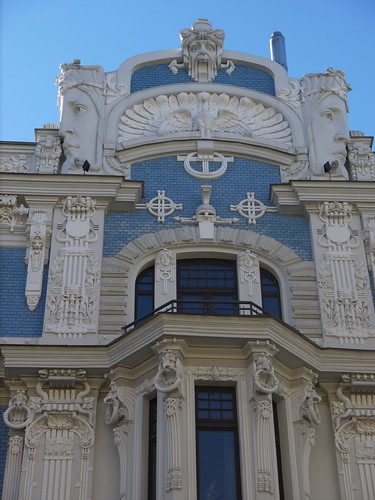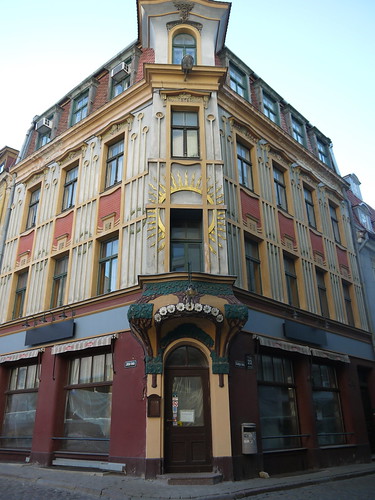It is eight years since I was last in Riga. Much has changed and much has remained the same. The city will be Europe's Capital of Culture in 2014 and compared to eight years ago it is not difficult to see why. Much of Riga's architectural legacy has been, or is being restored or cleaned up - although much more remains to be done; there are many more good quality restaurants than in 2005 and service generally is better - although scratch a little and its still relatively easy to find a fair amount of grim, glum Soviet style service.
I spent last weekend in Latvia's capital city, with the intention of having another look at the wonderful collection of art nouveau buildings, of sniffing out as much modernist architecture as possible and seeing some of the art I hadn't known about before. Despite seriously cold weather - minus 16 at one point during the weekend, I managed to achieve almost all of this. Oh, and kudos to the city council for clearing the footpaths of snow, all of which has been moved to the gutter in what has become a huge black glacier made of compacted snow and which will be interesting once it melts. Great for walking but maybe a little more attention to the ice on the cobbles in the old town. Losing my footing, I managed a passable version of River Dance trying to stay upright before crashing to the ground. Ouch! Those cobbles are hard. Good thing I had lots of extra clothes on.
So, about the art nouveau. The city has hundreds of such buildings as well as many in the local Baltic/ Scandinavian version - national romantic architecture, which I also like very much. During the four full days I was there I managed to complete four well planned self-guided walks that I found on this website. For this post, I will concentrate on some of my favourite examples of the city's art nouveau and national romantic buildings.
What better place to start than Alberta Street, a treasure trove of the two styles and home to one of my absolute favourites, the wonderful Boguslavsky apartment building at number 2 (pictured below) dating from 1906 and designed by none other than Mihails Eizensteins, who was responsible for some of Riga's most outstanding examples of art nouveau. The building is guarded by two sphinxes at it's entrance whilst the exterior of the apartment block is decorated with geometric and stylised ornaments with the facade boasting bands of glazed red tiles. The upper parts of the facade, through which the sky can be seen, feature mascarons and assorted geometric ornaments emphasising the self-importance of this stunning building. To add to its grandeur, the historian of ideas and philosopher Isaiah Berlin once lived here and there is a plaque to commemorate this.
The apartment building at Alberta Street 11 is an outstanding example of the more locally influenced national romantic school of architecture. Designed by another superstar architect of his time, Eizens Laube and built in 1908, it is not in good shape. Neglected, paint peeling and in need of a blooming good clean, this must have been a stunner when it was first built. Its facade has decorative detail that would be at home in Helsinki or Stockholm, as well as screw like turrets, whilst the amazing cylindrical towers in the rear courtyard (pictured below) were an unexpected find as I wandered in to this slightly forbidding space. I hope someone comes up with a sensitive plan to restore this gem before it deteriorates further.
Just around the corner from Alberta Street is Elizabetes Street, one of Riga's main boulevards and home to two more buildings associated with our Mr. Eizensteins. Number 10a (pictured below) is perhaps the best known of all of his buildings and the one that features on many of the postcards being sold around the city. It really is a stunner. Actually, the original architect for this building was Konstantins Peksens, another big name for the genre and the time, but it was Eizensteins who decorated the facade. The aloof, stylised female figures at the peak, the serpents and the screaming male heads refer to themes explored in symbolist art - conflicts between the calm and the chaotic and between good and evil. In the excellently illustrated book"Mikhail Eisentsein themes and symbols of art nouveau in Riga 1901-1906", Solveiga Rasa compares these figures and symbols to those that appear in the art of Knopff and Munch. I see the link. This is one of the better condition Riga art nouveau treasures and the facade has received tender love and care, its blue and white colours remaining crisp and clean.
Eizensteins was an interesting character. If the name is familiar it might be because his son was one Sergei who became one of the all time great directors or Russian (and world) cinema famous for that Odessa steps scene with the baby in the pram and the massive crowd scenes in the movie Battleship Potemkin. Sergei described his father as good natured and jovial with a sense of humour but also as pedantic with a passion for order, hard working and authoritarian. Despite the family name the Eizensteins were not Jewish - although Mihails' paternal grandparents had been German Jews who converted to Orthodox Christianity.
There are a number of places for the hungry traveller to refuel here. I really liked one of the new cafes that have sprung up - VinoMetr at Antonijas 13. Very cool and "modern Baltic" in its style and approach, it offers a business lunch from 12-4 on week days - 1, 2 or 3 courses for 3, 4 or 7 lats which is a little more than those numbers in sterling for good portions of good quality food. I had a very tasty leek and potato soup followed by raspberry cottage cheesecake and strong coffee. Recommended.
The area around Elizabetes Street and Alberta Street is the main focus for visitors wishing to experience art nouveau but there are also some excellent examples of the style in the old town - the other magnet for most visitors. As in many places, you have to look up to notice them as in many cases the ground floor has been altered to accommodate shops and other businesses. One such example is the lovely building at Skunu Street 10/12 (pictured below). Designed by architects Heinrihs and Fridrihs Sels and built in 1902, this highly decorative building was originally owned by a successful local businessman called Detmann, one of the owners of the Union stock company. Mr. Detman's initials can be seen on the facade, which is decorated with stylised plants including reeds, poppies, narcissus and chestnut leaves. The show stopper here though is the magnificent two storey bay window again decorated with floral motifs. Skunu is a very narrow street and it can be dark there even during the day. You need to stand a little way down the street and on the opposite side to look up and see a humorous feature - a dog above the bay window, obviously on guard duty!
For those inclined towards the finer things of life, such as great coffee, cakes and (passable) hot chocolate, there is a great pit stop just around the corner from Skunu Street - the Rigensis bakery, patisserie and cafe at Tirgonu Street 8. Don't be put off by the slightly grumpy Kat Slater look-a-like, who was actually very nice after some initial frostiness and do try the excellent cheese pastry, cheese cake or cherry strudel. Nice surroundings too. I went twice.
Back to the buildings. Still in the old town centre at Kaleju 23 (pictured below), you can find possibly the most colourful building in the city. Designed by Jewish architect Paul Mandelstam as a rental building with shops and built in 1903, it stands out from its neighbours due to its ornate facade which includes a bay window encircled with flora, a gilded representation of the sun symbolising life and restoration and a riot of colour above the doorway. Mandelstam designed many buildings in the city. Born in Lithuania, he was murdered during 1941 together with several other Jewish notables - a precursor to the devastation that the occupying Germans would inflict on Latvia's Jews. The building is currently undergoing some internal renovation and is therefore not in use. The ground floor was previously a cafe.
There are yet more examples of art nouveau and national romanticism in the streets running from the opera house beyond Elizabetes Street including Lacplesa Street. My favourite example of the national romantic style can be found in this street at number 51 (pictured below). A huge, imposing corner building by Eizens Laube dating from1909, it has a riot of decorative features on each facade including geometric designs and balconies. I especially like the wedge shape on the corner of the building that has more than a passing resemblance to some of the modernist buildings that were to come in the following decades. Nice one Mr. Laube!
The city really does has a magnificent, possibly the best collection of this much loved genre, but Riga has a lot more than that. More posts to follow on my modernist discoveries, some fantastic artists from the 1920's and 1930's and a little about the former glories of Jewish Riga. You know I might even go back next year for the Capital of Culture celebrations!
You can see many more examples of Riga's art nouveau, as well as other pictures of the city here. Riga






No comments:
Post a Comment